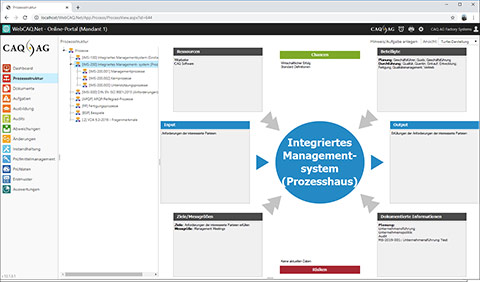Process Visualization with Turtle Diagrams
Whether organizing company structures, depicting responsibilities, or communicating interdepartmental SOPs – processes are the centrepiece of corporate leadership and the key to successful company management and product development. Apart from structuring day-to-day business, the transparent visualization of processes, responsibilities, targets and risks also directly assists companies on their way to successful certification.
 Process Visualization with Turtle Diagrams
Process Visualization with Turtle Diagrams
Turtle Diagram
The Turtle Diagram is a method for process analysis and planning used in quality management. Process steps or entire processes are visualized in shape of a turtle, as viewed from above. Elements such as input/output, required resources or responsibilities are allocated to the head, tail, and limbs of the turtle.
Questions such as the following are applied in order to describe or analyse the desired process elements:
- What and Why (Input): What are the causes of the process and what should it achieve?
- With What: What resources or tools are required for the process?
- Who: Who is responsible, who is involved in the process, and who will be affected by it?
- What Results: How can I measure the effectiveness of the process and how can I establish whether or not the targets of the process have been achieved?
- How: What methods should be applied and what information needs to be available?
- What (Output): What is the actual result of the process?
The Turtle Diagram is highly suitable for increasing a company’s overall process orientation and can be applied for visualizing a variety of quality management processes in areas such as risk management, audit preparation, or critical point analyses. When using the Turtle Diagram it is necessary that due diligence is exercised, as only when all questions have been answered in full, has the process been described in its entirety. Possible interconnections with other applicable processes should also be considered when working with the turtle model.
Dynamic Processes and Workflows
The BPM Software Process.Net not only supports the user during the visualization of processes via the Turtle Diagram, but also facilitates the creation and management of processes via flowcharts or, for example, IATF-compliant APQP forms. The direct interplay with other CAQ.Net modules means that real-time information regarding the validity of attached process documents or required employee skills is always available, as said information is retrieved directly from within the applicable document or training management module. Applying a risk-based approach as required by the ISO 9001 is also possible in Process.Net, because all processes can be equipped with a dynamic risk-matrix which depicts the possible risks and chances for the company right next to the process itself.
Everyone on Board
With its various web applications, CAQ.Net provides sophisticated management solutions for the company-wide exchange of process-relevant data. These applications are highly refined tools for practicing browser-based and cross-platform quality management wherever you are and always ensure that the people required for a given process can participate and be kept up-to-date. Regardless of whether you are using a Tablet PC, Smartphone or Desktop System, entering data via keyboard, mouse or touchscreen – CAQ.Net will always display and provide interactive access to precisely the information you want, when you want it, where you want it, and how you want it.